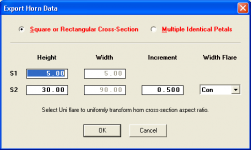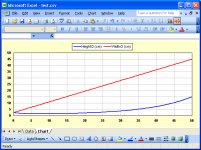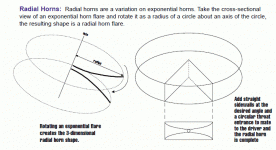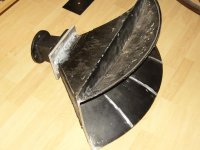Do you have any ideas on how to use data from Hornresp to design radialhorns?
Hi Lars,
When exporting the horn data, simply set the Width Flare to 'Con'.
Kind regards,
David
Hi kahvis,
If that's what your Hornresp simulations are indicating, then I expect it may well be the case.
I wouldn't have thought so, but I am not an expert on such matters 🙂.
Kind regards,
David
Is that true the 1. tapped horn have a better impulse response than 2.?
If that's what your Hornresp simulations are indicating, then I expect it may well be the case.
I have noticed that the shorter S1 - S2, give the better impulse response, but is that important difference in subwoofer frequences like 100hz and below?
I wouldn't have thought so, but I am not an expert on such matters 🙂.
Kind regards,
David
Hi kahvis,
If that's what your Hornresp simulations are indicating, then I expect it may well be the case.
It seems in the hornresp schematic view that tapped horn simulating is more optimized for a offset drivers. In the picture the 1. tapped horn have a driver in the throat of tapped horn. Then S1 - S2 is almost zero?
Thanks for helping
In the picture the 1. tapped horn have a driver in the throat of tapped horn. Then S1 - S2 is almost zero?
Hi kahvis,
Correct.
To simulate the 1. tapped horn configuration, set L12 = 0,01 cm.
Kind regards,
David
Hi David,When exporting the horn data, simply set the Width Flare to 'Con'.
This should be to much of a approximation. This as length will be another due to the area will be larger for the same length at 0 degrees as the mouth is curved. The sides of the Con will be too long.
If we use a flare like tractrix where design is made from the mouth and backwards to the point where it is square, a radial will work. After that adding a square to round section to the driver. This should be done to give a smooth transition to the radial section. Otherwise a JBL 2328 could be added. I don´t thin it will be good idea to place the driver directly to the radial section.
Altec 511 is a rough example of an old exponential design.
These are my thougths(guesses) about it.
This was hard to explain in English. Hope it is understandable.
This as length will be another due to the area will be larger for the same length at 0 degrees as the mouth is curved. The sides of the Con will be too long.
Sorry, something is wrong here😱. Have to give it some more thought. Probably the area should be the same but the sides shorter?
For me it "feels" right that the length is the same at every angle.
Last edited:
For me it "feels" right that the length is the same at every angle.
Hi Lars,
There is no reason why the mouth fronts of the top and bottom panels of the radial horn specifed by Hornresp couldn't be curved or 'rounded' and the mouth sides shortened accordingly, if so desired. Either way, the horn planar area expansion rate will still be correct.
The attachments refer to an exponential horn having S1 = 25 sq cm, S2 = 2700 sq cm and L12 = 50 cm.
The flare profiles shown in attachment 2 assume S1 = 5H x 5W and S2 = 30H x 90W.
If you want curved wavefronts to expand at an exponential rate however, then that is a different story 🙂.
Kind regards,
David
Attachments
Hi David,
The question was how to get a profile that is the same from side to side in a Con horn. Is this a feature I have missed? What I get is a varying profile that is to long(stretched) at the sides.
It is not a curved wavefront I want, it is a curved(radial) hornfront making the profile the same from side to side. This also mean the area is measured radial in the horn. It is, as I understood it right, how a radialhorn is defined. It might though be acoustically wrong.
This is tractrix spreadsheet I found. I haven´t analyzed it though.
The question was how to get a profile that is the same from side to side in a Con horn. Is this a feature I have missed? What I get is a varying profile that is to long(stretched) at the sides.
It is not a curved wavefront I want, it is a curved(radial) hornfront making the profile the same from side to side. This also mean the area is measured radial in the horn. It is, as I understood it right, how a radialhorn is defined. It might though be acoustically wrong.
This is tractrix spreadsheet I found. I haven´t analyzed it though.
Attachments
Last edited:
This also mean the area is measured radial in the horn.
Hi Lars,
In that case, Hornresp will not give you what you want 🙂.
I misinterpreted your definition of radial horn - my mistake, sorry.
Kind regards,
David
Here's a drawing from the Quadratic Waveguide whitepaper by Hughes, showing how a radial horn is defined.
Thanks Bjørn, now I understand 🙂.
Kind regards,
David
David,
To bad it wasn´t possible.
Bjørn,
Thanks for showing my (hard to understand)text in pictures.
To bad it wasn´t possible.
Bjørn,
Thanks for showing my (hard to understand)text in pictures.
This is tractrix spreadsheet I found. I haven´t analyzed it though.
The spreadsheet doesn't have any calculation of the basic areas, it just takes in distance, radius and area. So I guess you could take the exported distance and radius values from Hornresp, and put them into the spreadsheet to get the radial horn dimensions.
Bjørn
Noticed they lacked but you can take the data either from Hornresp or use the original equations(as I do for Exp, Kw(S) or Tx. Haven´t tried to export the text-files from Hornresp. LC must be taken from Hornresp.
Just for fun, this an (not so typical) example that I still haven´t finished: An Altec 511 Exp rebuilt for taking a 2" driver with help of a JBL 2328 adapter.
Just for fun, this an (not so typical) example that I still haven´t finished: An Altec 511 Exp rebuilt for taking a 2" driver with help of a JBL 2328 adapter.
Attachments
Last edited:
Hy everyone. I am having a hard time fiddling out some correct Driver paramaters of "typical" PA-High Frequency drivers in order to simulate some horns from 1-20kHz. Simply measuring the TSP gives strange results...
Does anyone have some reliable real-world driver-parameters as a starting point for one of "the usual" 1", 1.4" or 1.5" drivers (B&C, BMS, 18S... not really important, it´s more an academic issue - we want give the CNC something "meaningful" to do and thought of starting building hornflares...)
Does anyone have some reliable real-world driver-parameters as a starting point for one of "the usual" 1", 1.4" or 1.5" drivers (B&C, BMS, 18S... not really important, it´s more an academic issue - we want give the CNC something "meaningful" to do and thought of starting building hornflares...)
Last edited:
Hello,
For a design not intended to be adapted to a special loudspeaker, you can set Eg = 0.
Doing this you'll have a constant velocity source replacing the loudspeaker.
No more need to introduce T&S parameters for the driver...
Best regards from Paris, France
Jean-Michel Le Cléac'h
For a design not intended to be adapted to a special loudspeaker, you can set Eg = 0.
Doing this you'll have a constant velocity source replacing the loudspeaker.
No more need to introduce T&S parameters for the driver...
Best regards from Paris, France
Jean-Michel Le Cléac'h
Hy everyone. I am having a hard time fiddling out some correct Driver paramaters of "typical" PA-High Frequency drivers in order to simulate some horns from 1-20kHz. Simply measuring the TSP gives strange results...
Does anyone have some reliable real-world driver-parameters as a starting point for one of "the usual" 1", 1.4" or 1.5" drivers (B&C, BMS, 18S... not really important, it´s more an academic issue - we want give the CNC something "meaningful" to do and thought of starting building hornflares...)
Hi everybody!
Have downloaded hornresp zip file, but I'm unsure something is wrong.
Zip have GOM player file I can not initiate 'cause of missing codec - but can not find codec on the link provided. Saiz the file is corrupted.
Lars (Revintage) has give me notepad, but seems to be I'm unable to paste it into hornresp.
Would someone be so kind to tell me what I am doing wrong way?
Thank's!
Have downloaded hornresp zip file, but I'm unsure something is wrong.
Zip have GOM player file I can not initiate 'cause of missing codec - but can not find codec on the link provided. Saiz the file is corrupted.
Lars (Revintage) has give me notepad, but seems to be I'm unable to paste it into hornresp.
Would someone be so kind to tell me what I am doing wrong way?
Thank's!
Last edited:
I am not sure if I understand correctly, but it seems you are trying to open a ZIP File with a media player?
Take Winrar (or 7Zip or Winzip or something else that´s capable of handling a ZIP File).
You need no codec. Codecs belong to the video/audio domain and are used to play music or films oder videoclips...
Take Winrar (or 7Zip or Winzip or something else that´s capable of handling a ZIP File).
You need no codec. Codecs belong to the video/audio domain and are used to play music or films oder videoclips...
Understand why you think so - my silly english 🙂, but not.
When I unzip hornresp there is also GOM file among hornrespons files. That file can not open.
I can open hornrespons and seems to me like it is working. But I can not (or don't know how!) paste notepad that i got into hornresp.
When I unzip hornresp there is also GOM file among hornrespons files. That file can not open.
I can open hornrespons and seems to me like it is working. But I can not (or don't know how!) paste notepad that i got into hornresp.
You have GOM player as default videoplayer and files with extension .dat setted to be opened with this soft. This .dat file is not to be managed outside of hornresp and is not a video data, is the database of your projects.
To use the notepad file save it into Import folder in the honrnresp directory. Run hornresp and use the option File -> Import -> Hornresp Record.
To use the notepad file save it into Import folder in the honrnresp directory. Run hornresp and use the option File -> Import -> Hornresp Record.
- Home
- Loudspeakers
- Subwoofers
- Hornresp



